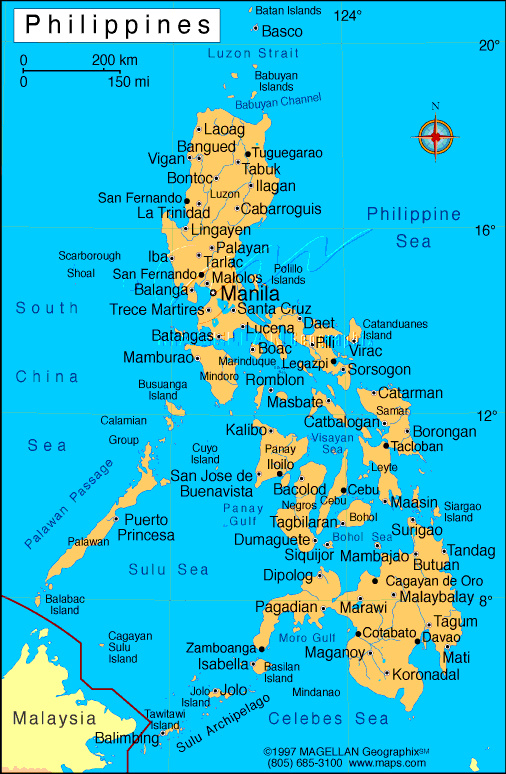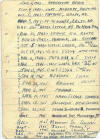|
|
HI! Dan
long time no talk. this is BUGSEY from the restored cg40450/cg40581.
I'am sending you this because I know you will love it. I met this man's
son Joe JR. in the doctors office when I was reading my CG manual for
the cg40450. He sit next to me and then said were you in the CG? I said
yes, why? I see that book your reading and it looks old and official. So
it went on "low and behold" his father served in World War 11 on the
83324/cg474 in the Pacific theater, like Bataan, Leyte and all around
there. Check out this scrap book and about 50 more original pictures.
You will love it as the next stop for this boy is a ticket to Washington
State if you know what I mean. How's those engines running? I just
finished rebuilding two turbo 671 for the 450 but the 190hp/671,s have
been running fine. Last year with all my 15 trips 120 running hours
total in two years, 185 hours, 1500 miles and still purring. I rebuilt 1
right hand rotation for the new boat (581) and it runs super at 40
hours. We had our 40 boat reunion, a 3 day affair that went over like a
big diamond ring. The boats never stopped for 3 days. They would come in
and go out. Every 40 boat coxswain who wanted to drive, drove the boat
then did the drills like we did 50 years earlier. It was out of site.
Guy's came from all over. The reunion was a great success. Go on Google
under cg405810 or cg40450. We did some drills with the 82'er LADY B, the
former USCG Point Brown 82362, now USCGAUX823258 commanded by Commander
Stew Sutherland from Staten Island N.Y. What's the latest on your boat?
I have been on the site a lot. Say in touch and tell me what you think
about the 883. |
|
BUGSEY |
 |
 |
 |
 |
|
|
|
|
|
|
|
Joseph E. Mutascio, Sr
(Dad)
|
Joseph E. Mutascio,
Sr. (Dad) served in the U.S. Coast Guard from July
of 1942 to March of 1946. He never really said why
the C.G.. I would guess it was his love of sailing
and the sea. Before leaving for the service a big
farewell party was held in his honor. As Dad always
loved a good party Iím sure a good time was had by
all.

Joe Mutascio,
second from right
Upon entering the C.G.
he attended boot camp at the Manhattan Beach
Training School in Brooklyn, NY. Before the war
Manhattan Beach was a summer vacation spot with
about sixty duplex bungalows. When the Coast Guard
took over, all the partitions were removed to make
room for 30 double deck bunks, rifle racks, 4
commodes and 2 sinks. Among other facilities,
barracks and training buildings were built. Thereís
nothing specific I was able to find in his
memorabilia that discusses Manhattan Beach, but then
itís hard to imagine even Dad even having fun at
boot camp.
Following Manhattan
Beach Dad attended basic training at the U.S.C.G
Training Facility, Fort McHenry, Baltimore, MD in
September of 1942. In 1942, the War Department
leased to the U.S. Coast Guard 8.4 acres of the park
at Fort McHenry, Baltimore, MD for the establishment
of a fire control and Port Security Training
facility. Along with ďCoastiesĒ, as they were
called, during the war local civilians were sworn in
at ceremonies to be trained in policing, sabotage
prevention, and fire-fighting damage control aboard
ships. The Fort McHenry Training Station began
operations on May 15th to train men and women in
port security work. Twenty temporary buildings were
erected on the east seawall grounds. With the end of
the war in August 1945, the Fort McHenry U.S. Coast
Guard had trained 28,053 personnel. I believe this
is where Dad met one of his life-long friends Joe
Siano, who hailed from Philly. Joe is a prominent
figure in many of the photos taken during Dadís time
in Baltimore. Joe later would be deployed to Europe
and participate in the Normandy Invasion. Later in
life Dad would become Joe Sianoís son, Joe Jr.
godfather.

After his training at
Ft. McHenry in Maryland Dad attended Motor
Machinistís Training School at the Brooklyn School
of Automotive Trades in Brooklyn, NY. This would
prepare him for his duty as the engine mechanic
aboard his 83í C.G. cutter. During this time Dad
stayed at the Hotel Sutton in NY. Not sure if itís
the same one but a Hotel Sutton still exists today
in NY.
Between August of 1943
and January 1945 Dad spent time stationed in
Norfolk, VA, Little Creek, VA, and Cape May, NJ.
Best I can tell he was stationed aboard the C.G.
Cutter 83324 while in Little Creek, VA. I think Dad
really enjoyed his time in Cape May. He loved
basketball and I think of all the sports it was his
favorite. He spent time playing for the C.G.
basketball team while stationed at Cape May and use
to like to tell the story about how they kept him
there because he was a good ballplayer.

With the escalation of
the war in the Pacific Dadís cutter was ordered to
NY in January of 1945. Apparently during this time
it was a common site in the harbors of New York and
Bayonne to see many cutters lined up waiting to be
loaded aboard liberty ships and deployed overseas
some to Europe to support the invasion at Normandy
and other like Dadís to the Pacific. For the first
time since itís inception the C.G. had been placed
under the operational control of the Navy. On
February 26, 1945 (as I write this exactly 59 years
ago today) Dadís cutter, 83324, was loaded aboard a
liberty ship in Bayonne, NJ and he sailed off to the
war in the Pacific. He was not allowed to reveal
his location or details of his destination or his
mission to family and friends at home, and for a
long time his mail and pictures were subject to
censorship.
After 9 days at sea he
arrived in Panama. He was able to go ashore in
Panama City while his ship prepared to pass through
the Panama Canal. Dad spent the day touring Panama
in a horse and buggy drinking rum and cokes for 15
cents. It was said to be a familiar sight in Panama
to see liberty ships going through to the Pacific
with a deck load of 83-footers. It took 8 hours for
his ship to pass through the Panama Canal which he
said was quite an experience and a marvel to see.
After that it was out to the vast Pacific. It must
have been something to see. He talked about it to
me later in his life.

Dad spent 43 days at
sea sometimes not seeing another ship for two weeks
at a time. To reach the Philippines the Allies used
two routes: one through the central Asia Pacific via
the Gilberts, Marshalls, Marianas, Carolines, and
Palaus; the other through the Southwest Pacific Area
via the north coast of
New Guinea. An
advantage of the second route was that it would
provide for land-based air cover along the way.
Dadís ship took the southern route.
After 43 days at sea
on April 10, 1945 his ship arrived at Manus Island
of the Admiralty Islands off the northern coast of
New Guinea. |
|
 |
|
After 43 days at sea
on April 10, 1945 his ship arrived at Manus Island
of the Admiralty Islands off the northern coast of
New Guinea. After that it was a short hop to
Hollandia, New Guinea (now Jayapura) a major
stepping stone for the Allies during the war.
|
 |
Hollandia, New Guinea
|
|
Finally on April 22, 1945 after 56 days his ship
arrived ad Samar Island, Guiuan in the Philippine
Islands. He would spend the next 10 months
stationed aboard the 83324 cutter at various
locations throughout the Philippines. His mission
was antisubmarine patrol in the island harbors.
Places like Tacloban, Leyte Islands, Mindanao, Pilar,
Iloilo, Panay and Manilla. |
 |
|
In August of 1945 the
U.S. ended the war against Japan suddenly with the
use of the A-bomb. At first the thought of seeing
Japan intrigued Dad but that didnít happen.
On January 16, 1946
Dad received news that his cutter, 83324 would be
decommissioned in the Philippines. January 25, news
came down that 49 men were being sent home. Again
through some error Dadís name was not on the list.
It sounds as though he had to raise some hell to get
his release. He once mentioned how he needed a
chaplain to assist him to get released. Finally on
February 14, word came down for his release. At
this point he was the only mechanic left on his
cutter. After a final inspection of his engine room
passed he was released to the Navy receiving station
on Samar Island. A short time later he was aboard
the U.S.S. Bronx on his way home via the west
coast. He was discharged from the service on March
22, 1946
 . .
Joseph E. Mutascio
The 83í
Cutter
The 83 footer story
began in 1940 when the first of 230 cutters was
built for the USCG. The wooden cutters were used for
convoy duty in the Gulf and ASW patrol off the east
coast of the U.S. From 1941-1945 the 83 footers
were used for antisubmarine patrol, coastal convoy
escort, and search and rescue. Spring 1944, 60 units
were shipped to Great Britain and became USCG Rescue
Flotilla No. 1 based at Poole, England, it deployed
in two 30-boat rescue groups for Normandy landings
and rescued 1,500. 30 of these 60 units returned to
the United States, 24 remained in Europe, 4 were
transferred to the Royal Navy, and 2 were lost. They
were also known as the Matchbox Fleet.
Crews averaged 13.
Besides the captain and chief boatswain's mate,
there were three motor machinist mates (Dad), one
fireman, one radar-sonar man, one gunners mate,
three boatswain mates, two seamen, and a cook.
January 1945, 30 units
were ordered to COMSERV7THFLEET in the PHILSEAFRON
as USCG PTC Flotilla Number One and operated out of
Manicani Island, just south of the island of Samar
near Leyte (Dadís 83324). None of these units had
served in Europe and none were returned to the
United States, all were decommissioned in the
Philippines and disposed of by the Foreign
Liquidation Commission (a branch of the U.S. State
Department).
24 additional cutters
were shipped to the Pacific to serve in Advance Base
Harbor Defense Force (ABHD) at bases in Okinawa and
Eniwetok in the Marshall Islands, and Saipan and
Guam in the Mariana Islands. The surrender of the
last Japanese bastion in the Marianas took place on
the deck of the 83434 when the Japanese formally
surrendered the island of Aquijan.
After the end of the
war the Coast Guard control transferred back to the
Treasury Department. 61 of the 83 footer fleet was
utilized by the Coast Guard for Search and Rescue.
During the cold war, most were assigned to Harbor
Entrance Patrol. The last 83 footer, the WPB-83484,
was decommissioned on April 15, 1963.

|
|
|
|
|
|
|
|
|
|
|
 |
 |
 |
 |
 |
|
|
|
|
|
|
_small.jpg) |
 |
 |
 |
 |
|
|
|
|
|
|
 |
 |
 |
 |
|
|
|
|
|
Go to HOME |
|